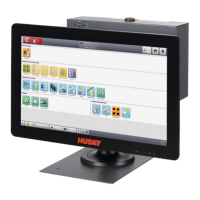v 1.0 — February 2020 Altanium Matrix5
10 Configure a Zone for Zero Cross Control
2.2.1 Configure a Zone for Zero Cross Control
This method defines how the power to each heater is averaged over a period of time. This is
done by switching between complete half cycles of the heater supply voltage with the use
of a snubberless TRIAC as a switch device.
2.2.2 Configure a Zone for Phase Angle Control
This method defines how the power to each heater is adjusted, by varying the point in each
half cycle at which the snubberless TRIAC (switching device) is turned on.
In either control method, the Altanium controller recalculates the power output
requirements for the entire system every 250 milliseconds to get the maximum control
resolution. Combine one or the other control methods above with the Active Reasoning
Technology (ART) control algorithm, and it is possible to get accurate temperature control
with the expectation of control accuracy of ± 1 digit under steady state conditions.
2.3 Determine the Heater Size
Hot runner molds can have different types of heat elements:
• Integral, which is a part of the probe.
• Cartridge, which is slid into the probe or directly into the mold steel.
In the manifold, a series of cartridge heaters or bent tubular style heaters are normally used.
The typical wire used inside an element is made of nickel-chrome, which is surrounded by
magnesium oxide. The size of this wire and number of turns determine its resistance, which
in turn determines its wattage (the amount of energy). This determines its performance in
the mold. Undersize heating elements (too little wattage) create a serious problem when the
control asks for power and none is available. In almost all cases it is better to be oversize than
undersize in a hot runner mold.
The Altanium controller provides wattage, resistance, or amperage information for heaters,
if equipped with X ICC
2
or X ICC
3
cards. This information can also be calculated with the use
of Ohm’s Law. The steps and formulas that follow show how.
1. On a multimeter, set the selector to measure resistance.
2. Place the (red) positive lead onto the first wire from the heating element and place the
(black) negative lead from the meter onto the second wire.
NOTE: These may be pins on a connector, or the zone output fuses in the system as long
as they are connected to the heating element.
The meter will show a resistance in ohms.
WARNING!
Electrical hazard - risk of death or serious injury. Disconnect all electrical power from
the mold and controller prior to performing this test.

